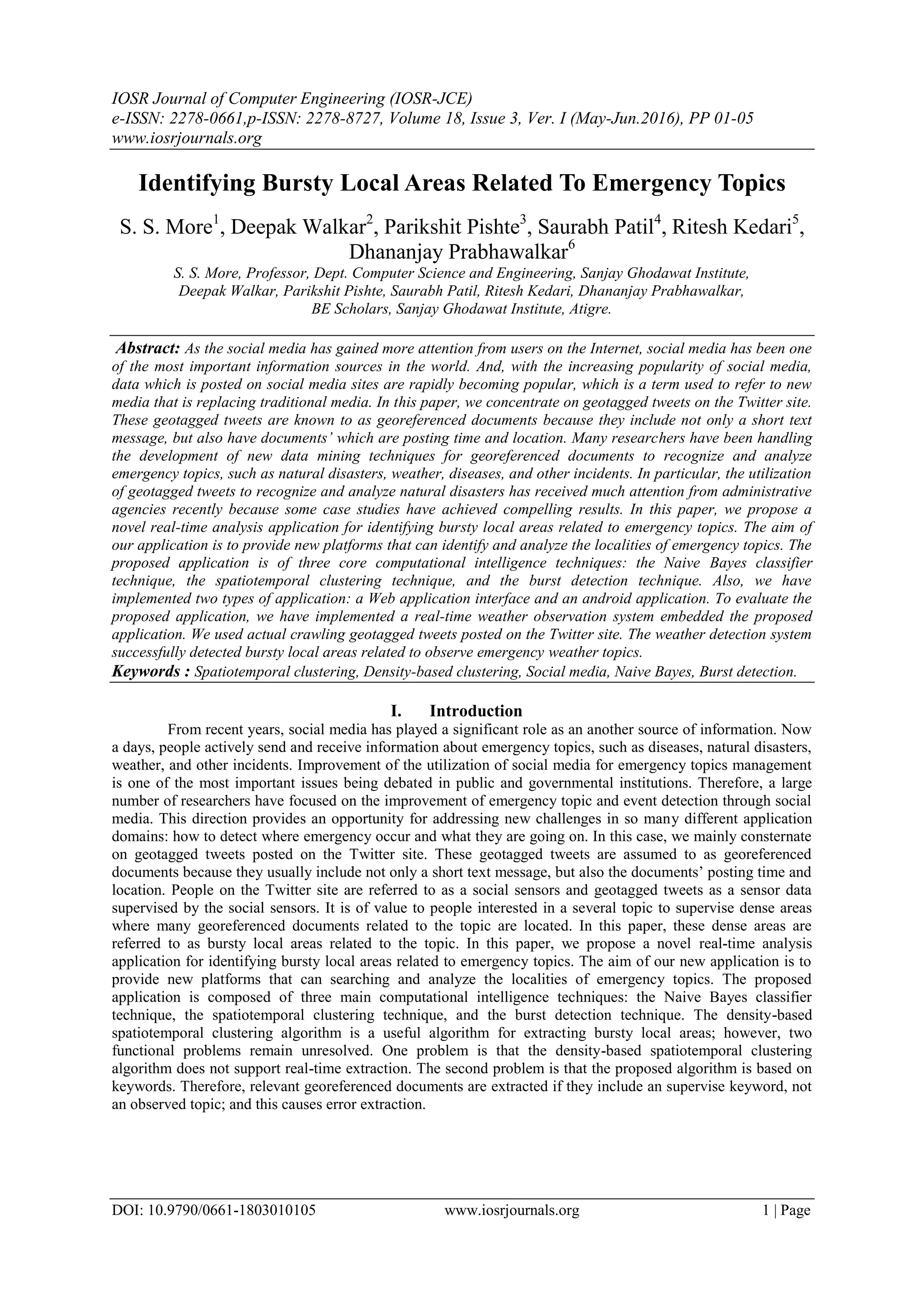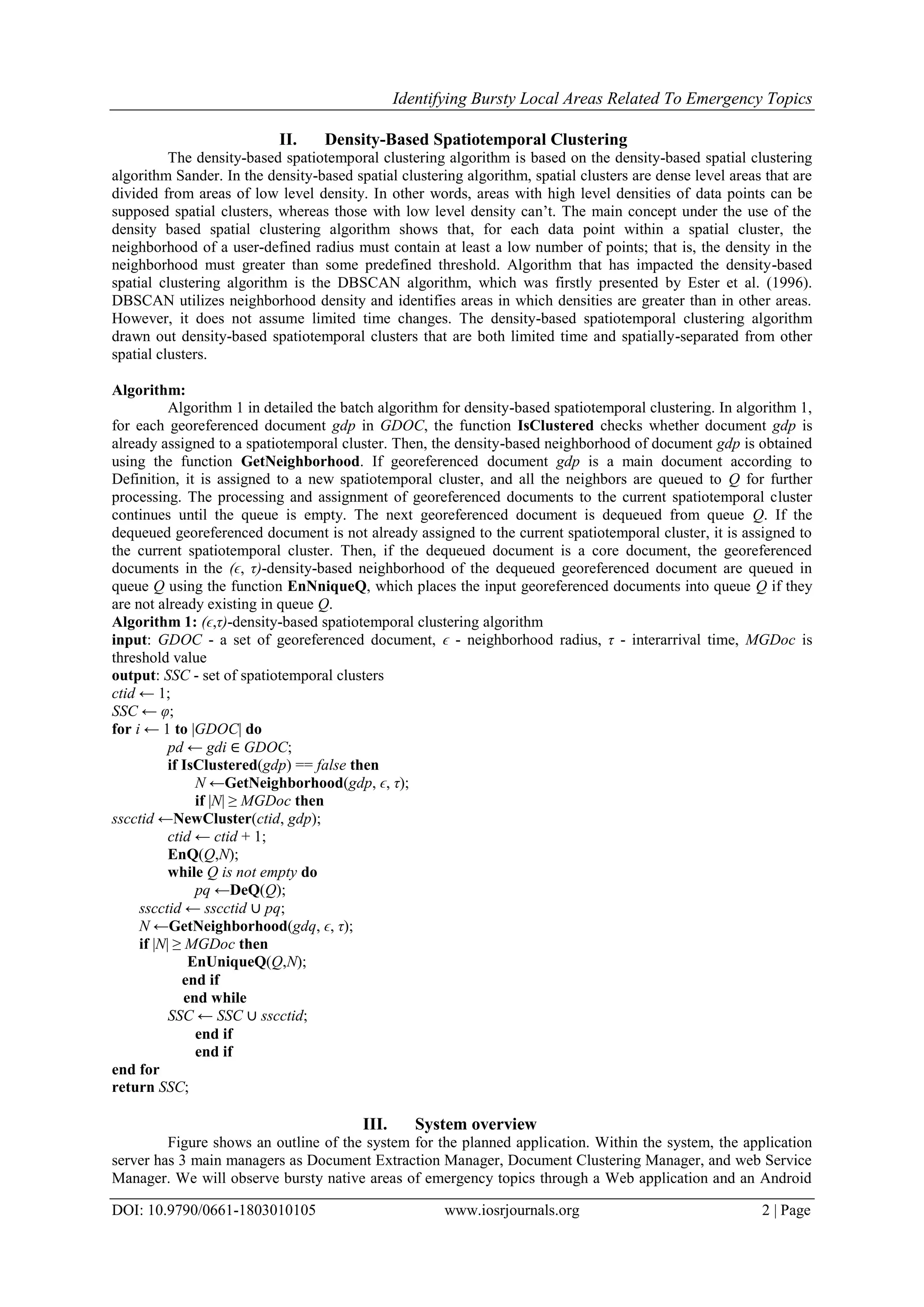This document proposes a novel real-time application to identify bursty local areas related to emergency topics using geotagged tweets. It uses three techniques: Naive Bayes classification to extract tweets related to emergency topics, density-based spatiotemporal clustering to group tweets by location and time into clusters, and Kleinberg's burst detection algorithm to identify clusters with higher tweet volumes indicating emergencies. The application was implemented as a web and mobile interface. It was tested in a real-time weather monitoring system using Twitter data and successfully detected bursty local areas for weather emergencies.



![Identifying Bursty Local Areas Related To Emergency Topics
DOI: 10.9790/0661-1803010105 www.iosrjournals.org 4 | Page
Algorithm
Algorithm 2: Incremental (∈, τ) - density-based spatiotemporal clustering algorithm
Input : gdoc - a newly input georeferenced document, GDOC - a set of georeferenced, CSSC - a set of extracted
spatiotemporal clusters, ∈ - user specified value, τ – user specified value, MGDoc - the minimum number of
georeferenced document
Output: NSSC - a set of updated patiotemporal clusters
NSSC ← CSSC;
RD ←GetRecentData(gdoc, τ ,GDOC);
for i ← 1 to |RD| do
pd ← rdi ∈ RD;
N ←GetNeighborhood(pd, ∈, τ);
if |N| ≥ MGDoc then
if IsClustered(pd) == false then
ssc ←MakeNewCluster(cid, pd);
end if
else
ssc ←GetCluster(pd, NSSC);
end if
EnQueue(Q,N);
while Q is not empty do
gdoc ←DeQueue(Q);
if IsClustered(gdoc) == true then
N ←GetNeighborhood(gdoc, ∈, τ);
if |N| ≥ MGDoc then
ssc ←
GetCluster(gdoc, NSSC);
ssc ←
AppendClusters(ssc, ssc);
end if
end if
else
ssc ← ssc ∪ gdoc;
N ←GetNeighborhood(gdoc, ∈, τ);
if |N| ≥ MGDoc then
EnNniqueQueue(Q,N);
end if
end if
end while
NSSC ← NSSC ∪ ssc;
end if
end for
return NSSC;
VI. Kleinberg’s Burst Detection Algorithm
Kleinberg defined a model with an continue state automaton in which bursts are represented as state
transitions. Suppose that there are m states in the automaton, every interarrival time is a probabilistic output that
depending up on the internal states of the infinite state automaton. In the model, a state is associated with a
burstiness state and a higher state indicates higher burstiness.
Algorithm: Location-Based Burst Detection
input : cutoff distance dist, user position up, word time-series data wi, and parameter list for burst detection
params
output: optimal state-transition sequence S
IAT′CTDi () /* make a empty sequence */
for j 1 to |w−> CTDi| do
if j = 1 then
pctd ← stime
else
pctd ← w−> CTDi[j − 1]
iat ← w−> CTDi[j] − pctd + _(wi−>](https://image.slidesharecdn.com/a1803010105-160704052203/75/A1803010105-4-2048.jpg)
![Identifying Bursty Local Areas Related To Emergency Topics
DOI: 10.9790/0661-1803010105 www.iosrjournals.org 5 | Page
CTPi[j], up)
IAT′CTDi append_sequence
(IAT′CTDi ,iat)
s KBD (IAT′
CTDi ,params)
return s
VII. Conclusion
So in this paper, we have developed web application and android application to identifying the bursty
local areas related to emergency topics. In additional we are also providing today’s hot topics from tweets are
fetched in our application for the development of our application. We have used naïve bayes classifier
technique, density-based spatiotemporal clustering algorithm and burst detection technique. We mainly focus on
geo tagged tweets and by extracting that tweets we plot the bursty local area on map, for which we have used
streaming API’s of twitter. In future we are planning to develop application in multi language.
VIII. References
[1]. Kaneko T, Yanai K (2013) Visual event mining from geo-tweet photos. In: Multimedia and Expo Workshops (ICMEW) 2013 IEEE
International Conference On. IEEE, San Jose, CA, USA. pp 1–6.
[2]. Tamura K, Kitakami H (2013) Detecting location-based enumerating bursts in georeferenced micro-posts. In: roceedings of the
2013 Second IIAI International Conference on Advanced Applied Informatics. IIAI-AAI ’13. IEEE Computer Society, Los
Alamitos, CA, USA. pp 389–394.
[3]. Tamura K, Ichimura T (2013) Density-based spatiotemporal clustering algorithm for extracting bursty areas from georeferenced
documents. In: Proceedings of The 2013 IEEE International Conference on Systems, Man, and Cybernetics, SMC 2013. IEEE
Computer Society, Los Alamitos, CA, USA. pp 2079–2084.
[4]. Abdelhaq H, Sengstock C, Gertz M (2013) Eventweet: Online localized event detection from twitter. Proc VLDB Endow
6(12):1326–1329.
[5]. Musleh M (2014) Spatio-temporal visual analysis for event-specific tweets. In: Proceedings of the 2014 ACM SIGMOD
International Conference on Management of Data. SIGMOD ’14. ACM, New York, NY, USA. pp 1611–1612.
[6]. Hiruta S, Yonezawa T, Jurmu M, Tokuda H (2012) Detection, classification and visualization of place-triggered geotagged tweets.
In: Proceedings of the 2012 ACM Conference on Ubiquitous Computing UbiComp. ’12. ACM, New York, NY, USA. pp 956–963.
[7]. Hong L, Ahmed A, Gurumurthy S, Smola AJ, Tsioutsiouliklis K (2012) Discovering geographical topics in the twitter stream. In:
Proceedings of the 21st International Conference on World Wide Web. WWW ’12. ACM, New York, NY, USA. pp 769–778.
[8]. Hwang M-H, Wang S, Cao G, Padmanabhan A, Zhang Z (2013) Spatiotemporal transformation of social media geostreams: a case
study of twitter for flu risk analysis. In: Proceedings of the 4th ACM SIGSPATIAL International Workshop on GeoStreaming.
IWGS ’13. ACM, New York, NY, USA. pp 12–21.
[9]. Mandel B, Culotta A, Boulahanis J, Stark D, Lewis B, Rodrigue J (2012) A demographic analysis of online sentiment during
hurricane irene. In: Proceedings of the Second Workshop on Language in Social Media. LSM ’12. Association for Computational
Linguistics, Stroudsburg, PA, USA. pp 27–36](https://image.slidesharecdn.com/a1803010105-160704052203/75/A1803010105-5-2048.jpg)